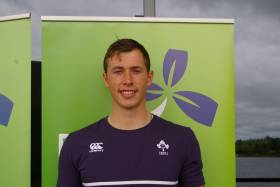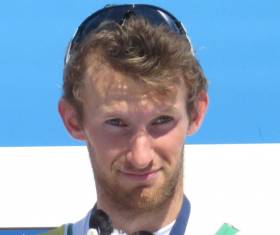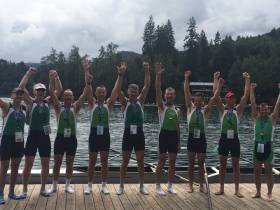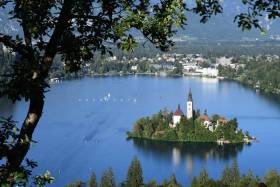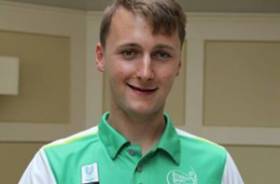Displaying items by tag: Ireland
Repechage Place for Ireland Pair after Sixth in World Rowing Heat
#Rowing: Ireland had to settle for sixth place in the first heat of the men’s pair at the World Rowing Championships in Sarasota-Bradenton in Florida today. The new crew of Fionnán McQuillan-Tolan and Patrick Boomer were never realistic contenders for one of the first two places, which would have sent them directly to the A/B semi-finals. They are now set for a repechage on Tuesday (5.24 or 5.29 Irish time).
Ireland’s three lightweight crews won their heats: single sculler Denise Walsh secured her win with a sprint finish, while Paul O’Donovan and the pair of Mark O’Donovan and Shane O’Driscoll won relatively easily.
World Rowing Championships, Sarasota-Bradenton, Florida – Day One – Irish Interest:
Men
Pair – Heat One (First two to A/B Semi-Final; rest to Repechage): 1 Italy 6:27.88, 2 France 6:33.03; 6 Ireland (F McQuillan-Tolan, P Boomer) 6:50.82.
Lightweight Pair – Heat One (First to A Final; rest to Repechage): 1 Ireland (M O’Donovan, S O’Driscoll) 6:33.20, 2 Britain (J Cassells, S Scrimgeour) 6:38.57, 3 Italy 6:40.39.
Lightweight Single Sculls – Heat Three (First Four to Quarter-Finals; rest to Repechages): 1 Ireland (P O’Donovan) 6:54.68, 2 Brazil 7:05.75, 3 Italy 7:09.88, 4 Thailand 7:17.50.
Women
Lightweight Single Sculls – Heat Three (First Three to A/B Semi-Finals; rest to Repechages): 1 Ireland (D Walsh) 7:43.87, 2 South Africa 7:44.38, 3 Italy 8:03.34.
Ireland and Britain Head-to-Head Early at World Rowing Championships
#Rowing: Mark O’Donovan and Shane O’Driscoll are Ireland’s first crew in action at the World Rowing Championships in Sarasota-Bradenton in Florida on Sunday. The lightweight pair take on Britain, Hungary and Italy – and if they win this heat at 3.10 pm Irish time they go directly to the A Final. Paul O’Donovan’s heat of the lightweight single sculls follows at 3.30 – he will have a more demanding programme, as he will only qualify for a quarter final by taking a top four place.
In quick succession there are heats for the Denise Walsh (4.01) and the men’s pair of Patrick Boomer and Fionnán McQuillan-Tolan (4.11).
The women’s pair, though an Olympic event, has 11 crews. So while Aileen Crowley and Aifric Keogh would have to win their heat (3.46 on Monday) to qualify for the A Final, they know that they have a repechage to come and a guaranteed place in at least the B Final.
Sanita Puspure goes at 4:32 on Monday. She has a tough heat, featuring Switzerland, Latvia and Bahrain, with the winner going to the A/B semi-final.
World Rowing Championships, Sarasota-Bradenton, Florida – Draw – Irish Interest:
Sunday (times Irish; heats)
3:10: Men’s Lightweight Pair – Mark O’Donovan, Shane O’Driscoll (Winner to A Final; rest to Repechages)
3:30: Men’s Lightweight Single Sculls: Paul O’Donovan (First Four to Quarter-Finals; rest to Repechages)
4:01: Women’s Lightweight Single Sculls: Denise Walsh (First Three to A/B Semi-Finals; rest to Repechages)
(Note!) 4:06: Men’s Pair: Patrick Boomer, Fionnán McQuillan-Tolan (First Two to A/B Semi-Finals; rest to Repechages)
Monday
3:46: Women’s Pair: Aileen Crowley, Aifric Keogh (Winner to A Final)
(NOTE!) 5:32: Women’s Single Sculls: Sanita Puspure (Winner to A/B Semi-Final)
Ireland Team Leave for World Rowing Championships
#Rowing: The Ireland team set off for the World Rowing Championships in Florida today. Gary O’Donovan accompanied the team, and was in good form despite having to pull out of competition due to a viral infection which has limited his training. He travels as reserve. The World Championships will start in Sarasota-Bradenton on Sunday (September 24th) and continue until Ocotber 1st.
Ireland Send Twenty-Three Crews to World Coastal Championships
#Rowing: Ireland will send a very big team to the World Coastal Rowing Championships in Thonon in France from October 13th to 15th. Twenty-three crews from nine clubs will represent the country. The top contender for honours is Monika Dukarska of Killorglin, the defending champion in the women’s single. Arklow, which hosted the recent Irish Offshore Championships, have entered nine crews.
Gary O'Donovan Out of World Championships
#Rowing: The Ireland team for the World Rowing Championships has been weakened by the non-availability of Gary O’Donovan through illness. The Skibbereen man formed the lightweight double with his brother Paul which took silver at the Olympic Games in 2016. Their 2017 campaign brought them silver at the European Championships and silver and bronze in World Cup regattas. Paul O’Donovan will now defend his World Championship title in the lightweight single sculls at this year’s regatta, which begins on September 24th in Sarasota-Bradenton in Florida.
Gary O’Donovan will travel to the Championships as a spare.
Ireland Team for World Rowing Championships, Sarasota-Bradenton, Florida, September 24th-October 1st:
Men
Pair: F McQuillan-Tolan, P Boomer. Lightweight Pair: M O’Donovan, S O’Driscoll. Lightweight Single Sculls: P O’Donovan
Women
Pair: A Crowley, A Keogh. Single Sculls: S Puspure. Lightweight Single Sculls: D Walsh.
Crowley Hits the Mark Twice as Irish Amass Masters Wins
#Rowing: Irish crews continued to amass medals on the second day of the World Masters Regatta in Bled in Slovenia. The composite eight from Galway, Commercial, Clonmel, Neptune and Cork had a fine win in a good time of just over three minutes for the 1,000 metres. Denis Crowley won in both the E and C age groups in the single sculls and two composite fours won.
World Masters Regatta, Bled, Slovenia, Day Three (Selected Results; Irish interest; all heats of 1,000 metres, winners only)
Men
Eight ‘C’ (Avg age 43 or more) – Heat Nine: Galway, Commercial, Clonmel, Neptune, Cork (M McGlynn, R Forde, P Fowler, A McCallion, C Moloney, O McGrath, G O’Neill, B Smyth, B Crean) 3:00.35.
Four ‘D’ (Avg 50 or more): Commercial, Clonmel, Neptune (A Penkert, B Smyth, M Heavey, O McGrath, J Hudson) 3:23.86.
Four ‘E’ (Avg 55 or more) – Heat One: Commercial, Belfast BC (F O’Toole, C Hunter, C Dickson, D McGuinness) 3:20.25.
Sculling, Single - ‘E’ (55 or more)– Heat Three: Commercial (D Crowley) 3:49.40. C (43 or more) – Heat 23: Commercial (Crowley) 3:45.30
Irish Scullers, Pair and Four Win at World Masters
#Rowing: Two Irish scullers, a four and a pair led the Irish charge at the World Masters Regatta in Bled in Slovenia today. Denis Crowley of Commercial and Sean Heaney of Galway joined John Hudson and Gerry Murphy of Neptune as medal winners. The four of Rob Forde, Patrick Fowler, Oisin McGrath and Gary O’Neill also won – but after being adjudged late in the heat they had entered. They were moved into another heat, and came out on top there.
Three Irish eights just missed out, taking second place in their heats.
World Masters Regatta, Bled, Slovenia, Day Two (Selected Results; Irish interest; all heats of 1,000 metres, winners only)
Men
Four ‘C’ (avg age 43 or more) – Heat Five: Commercial, Clonmel, Neptune (R Forde, P Fowler, O McGrath, G O’Neill) 3:18.46.
Pair ‘E’ (avg 55 or more) – Heat Six: Neptune (J Hudson, G Murphy) 3:41.11.
Sculling, Single ‘D’ (50 or more) – Heat 11: Galway RC (S Heaney) 3:50.17. Heat 16: Commercial (D Crowley) 3:48.93.
Irish Crews Win at World Masters Regatta
#Rowing: Irish composite crews had good wins on the first day of the World Masters Regatta in Bled in Slovenia. The Irish B eight (average age 36 or more), which is formed from six clubs won. Two fours in the E class (average age 55 or more) also won – the Galway/Neptune combination by just .26 of a second. The decision was initially given to their German opponents.
World Masters Regatta, Bled, Slovenia, Day One (Selected Results; Irish interest; all heats of 1,000 metres, winners only)
Men
Eight, B (avg 36 or more) – Heat Five: Galway, Commercial, Shandon, Clonmel, Neptune, Cork 3:05.51.
Four, E (avg 55 or more) – Heat One: Galway, Neptune 3:26.26.
Heat Four: Waterford, Neptune, Commercial, Belfast BC 3:28.1
Ireland Women's Eight Slots Into Fifth in European Under-23 Final
#Rowing: Ireland finished fifth in the A Final of the women’s eight at the European Under-23 Rowing Championships today. The crew, stroked by Emily Hegarty were well behind the top four, which fought it out for medals, but beat Germany, as they had in the race for lanes on Saturday. Russia took gold, Romania silver and Britain won a battle for bronze by .36 of a second from Belarus.
European Under-23 Championships, Kruszwica, Poland, Day Two (Irish interest)
Men
Lightweight Single Sculls – A/B Semi-Final Two (First Three to A Final; rest to B Final): 1 Czech Republic 7:34.58, 2 Ireland (A Goff) 7:37.64, 3 Sweden 7:42.26.
Semi One: 1 Austria 7:32.69, 2 Turkey 7:34.45, 3 Slovenia 7:40.16
A Final: 1 Czech Republic 7:44.38, 2 Austria 7:46.64, 3 Slovenia 7:48.58; 5 Ireland (A Goff) 7:58.72.
Women
Eight – A Final: 1 Russia 6:45.58, 2 Romania 6:46.44, 3 Britain 6:49.16; 5 Ireland (R Gilligan, N Landers, C Feerick, C Dempsey, A Corcoran, O Forde, S O’Connor, E Hegarty; cox C O’Connell) 7:11.26
Goff Misses Out on a Medal at European Under-23 Champs
#Rowing: Ireland’s Andrew Goff finished fifth at the European Under-23 Rowing Championships in Poland today. Jan Cincibuch of the Czech Republic won gold. He finished ahead of Austria, Slovenia and Turkey, who battled it out for the other medals, with Turkey’s Enes Yenipazarli missing out, though he had shown real guts to take on Cincibuch. Goff was not able to bridge the gap to this leading group.
The Ireland women’s eight are set to compete in their A Final in Kruszwica at 1.45 Irish time.
European Under-23 Championships, Kruszwica, Poland, Day Two (Irish interest)
Men
Lightweight Single Sculls – A/B Semi-Final Two (First Three to A Final; rest to B Final): 1 Czech Republic 7:34.58, 2 Ireland (A Goff) 7:37.64, 3 Sweden 7:42.26.
Semi One: 1 Austria 7:32.69, 2 Turkey 7:34.45, 3 Slovenia 7:40.16. A Final: 1 Czech Republic 7:44.38, 2 Austria 7:46.64, 3 Slovenia 7:48.58; 5 Ireland (A Goff) 7:58.72.



























